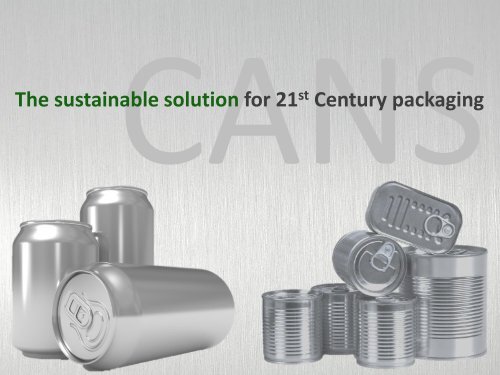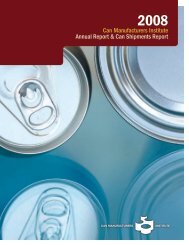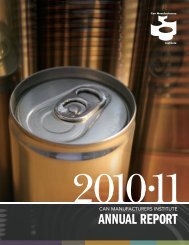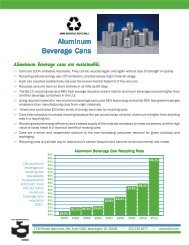Sustainability Report - Can Central
Sustainability Report - Can Central
Sustainability Report - Can Central
Create successful ePaper yourself
Turn your PDF publications into a flip-book with our unique Google optimized e-Paper software.
The sustainable solution for 21 st Century packaging
Packaging and <strong>Sustainability</strong><br />
Our natural world is being degraded and finite resources are being depleted as<br />
global population rises and developing nations grow their economies. That<br />
begs the question, how can we meet the needs of today without impairing<br />
the ability of our children and grandchildren to meet theirs?<br />
Providing the goods and services that fuel our economy must be done in a way<br />
that places the least stress on an already overly burdened planet. Packaging is<br />
no exception. Endlessly recyclable aluminum and steel cans provide an<br />
example of the positive role packaging can play in supporting a sustainable<br />
society.<br />
First, the can is the most recycled food and beverage container in the U.S. This<br />
greatly reduces the amount of material going to landfills.
Second, cans are made with more recycled content than most package types,<br />
which reduces the demand for new natural resources. And the natural<br />
resources that are required – aluminum or iron – are, respectively, the third and<br />
fourth most abundant materials on Earth.<br />
Finally, cans offer the best protection for the product inside. No other package<br />
provides a longer shelf life, better preserves product quality and offers greater<br />
protection against spoilage and food borne pathogens.<br />
The can clearly stands as the sustainable solution for<br />
21 st Century packaging.
The <strong>Can</strong> is the Sustainable Solution.<br />
Here’s why:<br />
1. <strong>Can</strong>s are the most recycled food and beverage package in<br />
the United States.<br />
2. <strong>Can</strong>s are produced with abundant and recycled materials.<br />
3. <strong>Can</strong>s save energy.<br />
4. <strong>Can</strong>s ensure safe, nutritious food and beverages.<br />
5. <strong>Can</strong>s prevent spoilage and product waste.<br />
6. <strong>Can</strong>s are economically efficient.
1. <strong>Can</strong>s are the most recycled food and<br />
beverage package in the United States.<br />
Minimizing landfill waste<br />
The can is the sustainable solution.
1 Steel Recycling Institute, 2011 rate<br />
2 Aluminum Association, 2011 rate<br />
3 EPA’s 2010 MSW Characterization <strong>Report</strong><br />
4 EPA ‘s 2009 MSW Characterization <strong>Report</strong><br />
5 EPA lists a broad category of “bags and wraps” in its recycling data, but does not break out flexible plastic packaging. The Flexible Packaging<br />
Association does not claim that flexible packaging is recyclable and instead claims that flexible containers are “pre-cycled.”<br />
Food and Beverage Package<br />
Recycling Rates<br />
Steel food can (70.8%)<br />
1<br />
Aluminum beverage can (65.1%)<br />
2<br />
Glass (33.4%)<br />
PET (29.2%)<br />
Aseptic cartons (6.5%)<br />
3<br />
3<br />
4<br />
Recycled<br />
Not-Recycled<br />
Flexible packaging (0%)<br />
5<br />
0% 20% 40% 60% 80% 100%
Recycling facts: Aluminum cans<br />
‣ The highest recycling rate of all<br />
beverage packages in the U.S.<br />
‣ 100% recyclable<br />
‣ Endlessly recyclable<br />
‣ Due to the high value of aluminum,<br />
cans self-finance their recycling<br />
‣ Aluminum cans have a true closedloop<br />
recycling process with old cans<br />
being recycled into new cans
Recycling facts: Steel cans<br />
‣ The highest recycling rate<br />
among food packages in the U.S.<br />
‣ 100% recyclable<br />
‣ Because of its magnetic<br />
properties, steel can be easily<br />
reclaimed from the waste<br />
stream and recycled endlessly<br />
‣ Steel is the most recycled<br />
material globally<br />
The can is the sustainable solution.
2. <strong>Can</strong>s are produced with abundant<br />
and recycled materials.<br />
Minimizing natural resource depletion<br />
The can is the sustainable solution.
The can minimizes resource depletion.<br />
Here’s why:<br />
1. The virgin materials that go into a can<br />
– aluminum or iron – are the third<br />
and fourth most abundant elements<br />
on Earth.<br />
2. <strong>Can</strong>s have high recycled content.<br />
Aluminum beverage cans average<br />
68% recycled content.<br />
3. Because cans are endlessly<br />
recyclable, they provide continuous<br />
feedstock for new cans.
Metal: A permanent resource for current<br />
and future generations.<br />
Credit:<br />
Metal has<br />
many<br />
applications.<br />
Ore supplies are<br />
abundant, and once<br />
extracted, are<br />
permanently<br />
available and<br />
endlessly<br />
recyclable.
1 Aluminum Association. 2011.<br />
2 “Lifecycle Analysis of Aluminum Beverage <strong>Can</strong>s,” Prepared May 21, 2010 for Aluminum Association<br />
Aluminum: Nearly 75% of all aluminum<br />
that’s ever been produced is still in use. 1<br />
It just keeps coming back in the form of new products.<br />
In the case of a beverage can, it can be recycled<br />
and back on a store shelf in just 60 days. 2<br />
60 Days<br />
60 Days<br />
60 Days
80-90% of all steel ever produced<br />
is still in use. 1<br />
Metal maintains its molecular structure<br />
throughout the recycling process,<br />
enabling it to be endlessly recycled into<br />
new steel products, such as cars,<br />
bridges or other cans.<br />
Chances are, the next can you pick up will<br />
contain metal that was used by your<br />
grandparent’s generation and will someday<br />
be used by your grandchildren’s<br />
generation. Reusing limited resources<br />
over and over epitomizes sustainability.<br />
1<br />
World Steel. 2011.
Less metal is needed to produce today’s cans<br />
In addition to high recycled content, cans also require less metal<br />
today. Over the past two decades, innovations in “light weighting”<br />
technology have enabled the industry to reduce the amount<br />
aluminum and steel needed to produce each can.<br />
15% reduction in aluminum since 1993 1<br />
31% reduction in steel since 1990 2<br />
1<br />
“Lifecycle Analysis of Aluminum Beverage <strong>Can</strong>s.” Aluminum Association. May 21, 2010.<br />
2<br />
“<strong>Sustainability</strong> and Steel Packaging.” www.steel.org. American Iron and Steel Institute. 2011.
3. <strong>Can</strong>s save energy.<br />
Reducing pollution and carbon emissions<br />
The can is the sustainable solution.
The can’s endless recyclability also saves<br />
significant energy.<br />
Being endlessly recyclable doesn’t just cut down on landfill space and the need<br />
for raw materials. Each can that is recycled greatly reduces the energy and<br />
therefore the carbon footprint of the next. That’s because it takes far less<br />
energy to produce the aluminum and steel for a can when using recycled<br />
material.<br />
Energy savings:<br />
Energy savings:<br />
95% 1<br />
75% 2<br />
1<br />
“Lifecycle Analysis of Aluminum Beverage <strong>Can</strong>s,” Prepared May 21, 2010 for Aluminum Association<br />
2<br />
“Facts About Steel Recycling.” Steel Recycling Institute. 2010.
Every can recycled saves energy:<br />
=<br />
X 1 hour<br />
1 x<br />
=<br />
1 load laundry<br />
Source: Woods, Jim. Steel Recycling Institute. 2010.
Every can recycled saves energy:<br />
=<br />
X 3 hours<br />
1 x<br />
=<br />
100 w<br />
X 4 hours<br />
Source: “Facts About Aluminum Recycling.” Earth911.org. 2011.
And the energy savings don’t stop there.<br />
Product packaged in cans never requires freezing or<br />
refrigeration. In fact, canned foods require no energy at all<br />
during storage. 1 This saves energy for producers, shippers,<br />
retailers and consumers.<br />
1<br />
“From Farm to Table: An Energy Consumption Assessment of Refrigerated, Frozen and <strong>Can</strong>ned Food Delivery.” Kirsten Ritchie, B.S., M.S., P.E.,<br />
Scientific Certification Systems. 2005.
4. <strong>Can</strong>s ensure safe, nutritious food<br />
and beverages.<br />
Providing the highest degree of product quality<br />
The can is the sustainable solution.
Best protection for food and beverages<br />
Food and beverages packed in cans are protected by<br />
the most robust package available.<br />
The durable metal exterior, combined with an airtight<br />
seal, locks in the product’s quality, while locking out<br />
germs, air, light and other elements that degrade<br />
product quality and threaten consumer health.<br />
It’s the most tamper-resistant and tamper-evident<br />
package on the market.
Best protection against food-borne illnesses<br />
Furthermore, the canning process<br />
itself kills off bacteria and other<br />
harmful agents, ensuring safe and<br />
nutritious food for the consumer.<br />
According to the CDC, 48 million<br />
Americans fall ill and 3,000 die every<br />
year from food-borne diseases. 1 Foodborne<br />
illnesses cost Americans $77.7<br />
billion annually. 2<br />
The durable structure and air-tight seal<br />
on cans offers the most robust<br />
protection against food-borne illnesses.<br />
1<br />
“Estimates of Foodborne Illness in the United States.” www.cdc.gov. Centers for<br />
Disease Control and Prevention. 2011.<br />
2<br />
Journal of Food Protection. January 2012.
Farm-fresh quality long after the harvest<br />
<strong>Can</strong>ned food is picked at the peak of ripeness and immediately canned, locking<br />
in its flavor and nutrition.<br />
<strong>Can</strong>s ensure farm-fresh taste and nutrition long after the product was<br />
harvested.<br />
There are myths that canned food contains preservatives and that its nutritional<br />
value is degraded. The fact is, most canned food is packed in just water or<br />
another liquid, with other ingredients sometimes added for flavor. And studies<br />
have shown that fresh, frozen and canned foods have about the same nutritional<br />
value at the time of consumption. 1<br />
1<br />
“Nutritional Comparison of Fresh, Frozen and <strong>Can</strong>ned Fruits and Vegetables.” Joy C. Rickman, Diane M. Barrett, PhD, Christine M. Bruhn, Phd.
Better for the beer. Better for the Earth.<br />
<strong>Can</strong>s also offer better protection of beverage quality.<br />
Take beer for example. Its two greatest enemies are air and light and cans offer<br />
complete protection against both. It’s not surprising that a canned revolution is<br />
underway in the craft beer market, with more than 300 craft beers now<br />
available in cans.<br />
There is no dispute that only cans provide complete protection of beverage<br />
quality. And due to the can’s protective coating, the beer or other beverage<br />
maintains its true taste.
5. <strong>Can</strong>s minimize spoilage and<br />
product waste.<br />
Reducing food waste benefits consumers & society<br />
The can is the sustainable solution.
Food waste: A problem for consumers,<br />
producers, retailers and society<br />
Nearly half of all food grown in the<br />
U.S. goes to waste.<br />
According to a study by the University of Arizona,<br />
funded in part by the USDA, 40-50% of all<br />
harvestable food in the U.S. is discarded. 1<br />
Food waste also poses significant environmental<br />
problems. According to the EPA, food waste is now<br />
the single largest component of the landfill stream –<br />
a staggering 34 million tons of food is wasted each<br />
year. 2<br />
1<br />
Timothy Jones, PhD, Bureau of Applied Research in Anthropology, University of Arizona. 2004.<br />
2<br />
“Basic Information About Food Waste.” www.epa.gov. U.S. Environmental Protection Agency. 2011.
Solution: <strong>Can</strong>s<br />
<strong>Can</strong>s help minimize food waste by providing the<br />
longest shelf life of any package.<br />
Food packed in cans is protected from<br />
air, germs and other factors that cause it<br />
to spoil.<br />
Less spoilage = less waste.
Solution: <strong>Can</strong>s<br />
A recent study by the USDA Economic Research Service<br />
examined fresh, frozen and canned varieties of various<br />
fruits and vegetables. For many of the products examined,<br />
canned varieties had the lowest consumer loss estimate. 1<br />
Example: Sweet Corn<br />
Type Consumer loss 2<br />
Fresh 32%<br />
Frozen 36%<br />
<strong>Can</strong>ned 7%<br />
1<br />
“Consumer-Level Food Loss Estimates and their Use in the ERS Loss-Adjusted Food Availability<br />
Data.” USDA Economic Research Service. 2011.<br />
2<br />
The estimates for frozen and canned come from USDA ERS’s revised consumer loss estimates.<br />
A revised figure for fresh corn is yet to be determined; the figure cited in this example is from<br />
USDA ERS’s previous estimate.
Solution: <strong>Can</strong>s<br />
Example: Peaches<br />
Type Consumer loss<br />
Fresh 42%<br />
Frozen 35%<br />
<strong>Can</strong>ned 8%
6. <strong>Can</strong>s are economically efficient.<br />
Saving money for producers, retailers & consumers<br />
The can is the sustainable solution.
Economical to ship and store<br />
Shipping efficiencies<br />
The can’s light weight and cubic efficiency allows<br />
more product to be shipped using less fuel.<br />
Energy savings<br />
Product packaged in cans requires no<br />
refrigeration or freezing, saving money<br />
through warehousing, shipping and<br />
retailing.
Less food and beverage waste = Less money waste<br />
“…[S]ince we now throw away more food than anything else, that means we are throwing<br />
away a lot of our money. Often, simple changes in food purchasing, storage and preparation<br />
practices can yield significant reductions in food waste generation.” – U.S. EPA 1<br />
Food waste costs the U.S. economy more than<br />
$1 billion each year. 2<br />
The average family of four throws away nearly<br />
$600 annually in food waste. 2<br />
<strong>Can</strong>s help minimize food and beverage waste by<br />
providing the longest shelf life of any package.<br />
That means more profit for producers and retailers,<br />
and more money in the pockets of consumers.<br />
1 “Basic Information About Food Waste.” www.epa.gov. U.S. Environmental Protection Agency. 2011.<br />
2 Timothy Jones, PhD, Bureau of Applied Research in Anthropology, University of Arizona. 2004.
In summary:<br />
No package is perfect. Each one necessarily requires some degree of<br />
energy or natural resource inputs. The key is to determine which<br />
package provides the greatest overall benefit to consumers and<br />
society.<br />
That package is the can.<br />
It has the highest recycling rate, minimizing landfill<br />
waste. It is made from recycled and abundant<br />
materials, minimizing the depletion of scarce<br />
resources. And it’s the most durable and robust<br />
container, maximizing shelf life and ensuring the<br />
highest degree of product quality.<br />
Further, it’s light weight, cubic efficiency and lack of<br />
need for refrigeration or freezing allows it to be<br />
shipped and stored at an economical cost.
In summary:<br />
We in the can industry are proud of our environmental record. We have<br />
worked hard to increase recycling rates, reduce the amount of metal<br />
required to make a can and lessen our energy and carbon footprint.<br />
But we’re not resting on our laurels. With the dedication and ingenuity of<br />
our more than 33,000 employees in the U.S., we are continually striving<br />
to build upon our environmental record. We challenge other packages to<br />
do the same.<br />
The can is the sustainable solution<br />
for 21 st Century packaging.
Prepared by:<br />
www.cancentral.com/sustainability





